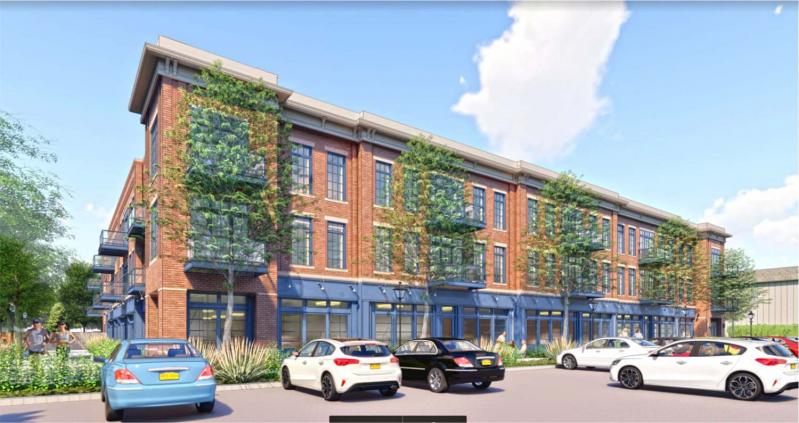Adam Potter has submitted an updated proposal to the Sag Harbor Planning Board for his mixed-use development on Bridge Street, offering a significant reduction from his earlier applications. Mr. Potter recently listed three of the five properties in his 11 Bridge Street L.L.C. for sale, and the new application, dated Feb. 16, is his first since then.
The new plan confines his proposed mixed-use building to only two lots, at 7 and 11 Bridge Street. Neither contains structures that contribute to the Sag Harbor Village Historic District, which removes the need for a variance that would have been necessary had the lots now on the market — at 8 Rose, 12 Rose, and 23 Bridge Street — been left in the application. The original plan, to demolish buildings that contributed to the historic district, was controversial, and surely would have set up a battle with the Village Board of Historic Preservation and Architectural Review.
"We've minimized the size and scope of the project," Mr. Potter said this week. "We listened, and we're not touching the contributing historic structures. We have addressed every single issue, including flooding, environmental concerns, and parking, that have been raised up until this point. There's only one reason why someone would continue to object, and that's because they don't want affordable housing in the village."
As now proposed, the 35-foot-tall three-story building contains 61,555 square feet, with 49,000 square feet devoted to housing: 28 market-rate apartments and 16 affordable units. "No retail will be permitted" reads a note on the application, with 7,935 square feet devoted to "service office/commercial oriented" uses. The commercial space would be located along the edge of the two parking lots that abut the northern and eastern portion of the combined parcels, which together are square shaped and just under an acre.
"It's less commercial space in that area than currently exists," according to the application. "As there are no retail store uses, this is not considered a 'superstore' as defined in the Village Code."
Parking for the estimated 88 residents would be on site, with 44 spaces included in a garage on the ground floor. Adjacent parking in the so-called gas-ball lot, which Mr. Potter leases, holds 93 spaces. Those spaces, however, are not designated residents-only, and the new proposal, like those that came before, still has parking issues: Mr. Potter is offering 44 parking spots, but 125 are required by code.
The building's first story would be "waterproofed," as it rests in a FEMA flood zone. The second and third stories would contain a mixture of one and two-bedroom apartments, enclosing an interior 3,140-square-foot courtyard. The smallest apartment is 800 square feet; the largest, 1,166 square feet.
"The upper floors are expected to provide views of the waterfront, where currently none exists," reads a coastal assessment form submitted with the application. The apartments without views of the harbor are clustered around the interior courtyard.
Mr. Potter hopes to connect the building to the village's sewer system. The apartment complex is estimated to generate over 10,000 gallons of wastewater; the village's wastewater treatment plant can treat up to 250,000 gallons daily, though even in the summertime it rarely gets past 180,000 gallons.
The new proposal notes, without getting into specifics, that application has been made to New York State for the cleanup of the property as a potential Brownfields site. "All existing sanitary systems are proposed to be removed, the site remediated prior to construction, thereby increasing the environmental benefits to the natural resources in the area."
"The design of the development is inspired by the existing architecture throughout the village and the East End," it continues. "This includes the commercial districts and its finer hotels and mixed-use commercial spaces. The aesthetic created would be similar to the mixed-use buildings on Main Street." Mr. Potter has always indicated that he is less concerned with the way the building looks than with its function, once remarking that he'd build it out of matchstick, if the village so desired.
To build the proposed $30-million structure, designed by BHC Architects, Mr. Potter will still need the planning board to grant site plan approval and a special-exception permit for the apartments. Because the lot area has shrunk, the required density variance has grown. In addition, variances for the third story (only two are permitted in the office district) and a setback variance for the rear yard are needed.
"We need housing," said Tiffany Scarlato, Mr. Potter's lawyer, in a phone call. "The state is putting out incentives for affordable housing, and here we have a person who has actually put pen to paper to develop some plans. Is there any other project east of the canal from a private developer who has wanted to do affordable housing?"
John Shaka, chairman of the planning board, said this week that he has reviewed the new plans with the village's consultant, Nelson Pope & Voorhis, but that it was unclear if it would land on Tuesday night's planning board meeting agenda.

